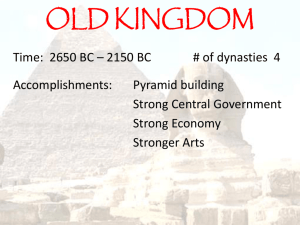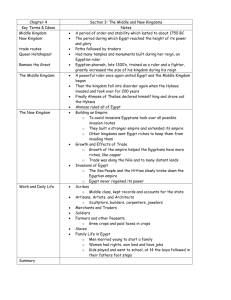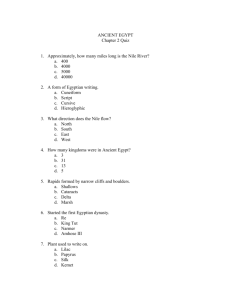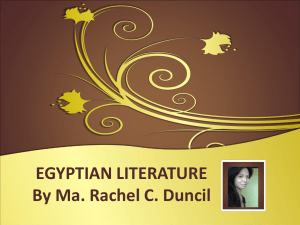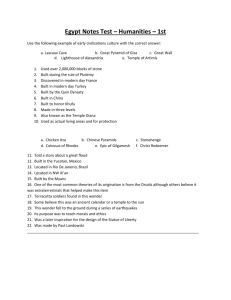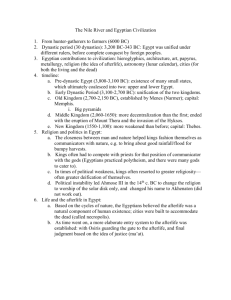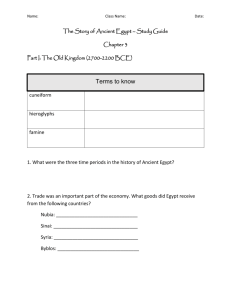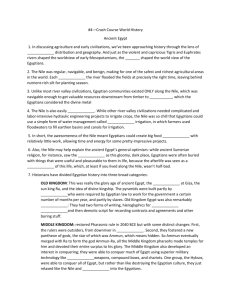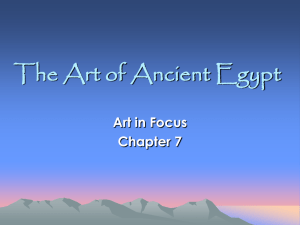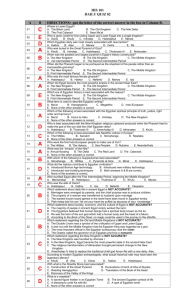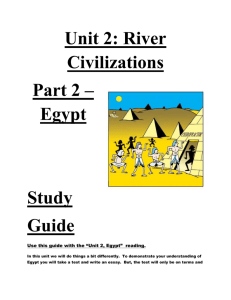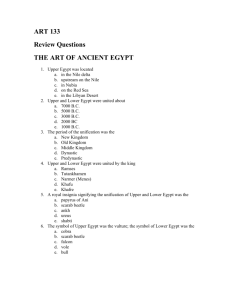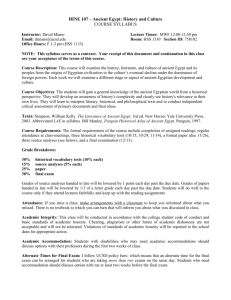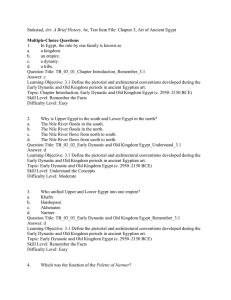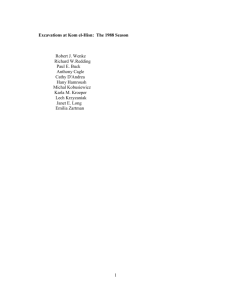EGYPT: DIRECTED VIEWING GUIDE - SOA Literary Arts
advertisement
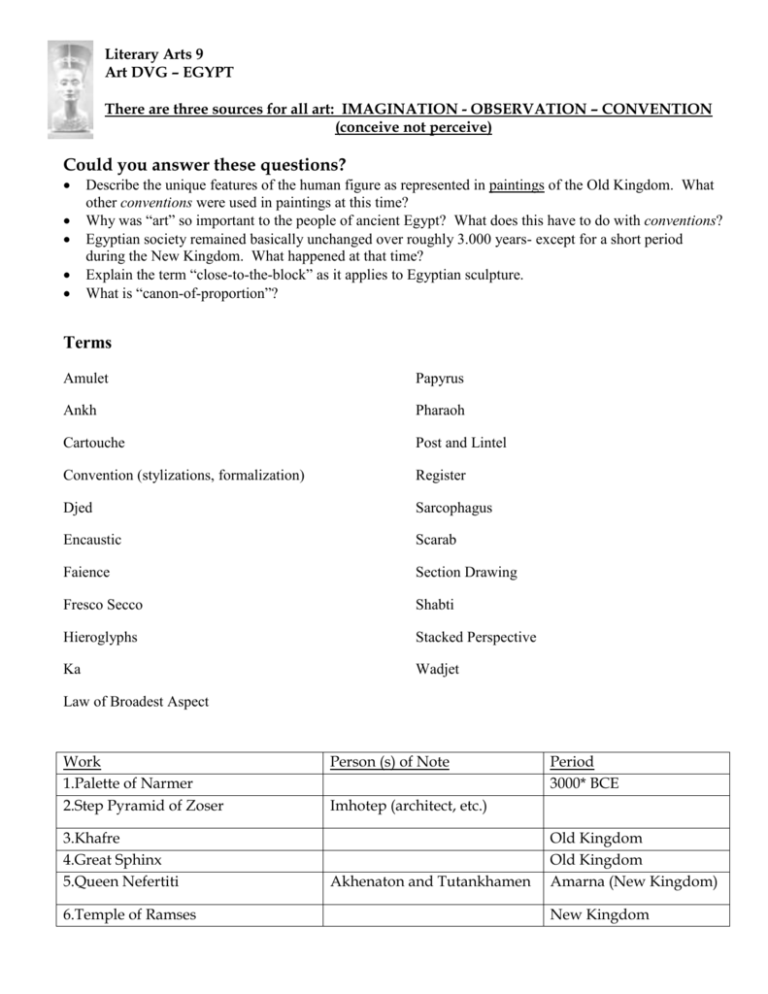
Literary Arts 9 Art DVG – EGYPT There are three sources for all art: IMAGINATION - OBSERVATION – CONVENTION (conceive not perceive) Could you answer these questions? Describe the unique features of the human figure as represented in paintings of the Old Kingdom. What other conventions were used in paintings at this time? Why was “art” so important to the people of ancient Egypt? What does this have to do with conventions? Egyptian society remained basically unchanged over roughly 3.000 years- except for a short period during the New Kingdom. What happened at that time? Explain the term “close-to-the-block” as it applies to Egyptian sculpture. What is “canon-of-proportion”? Terms Amulet Papyrus Ankh Pharaoh Cartouche Post and Lintel Convention (stylizations, formalization) Register Djed Sarcophagus Encaustic Scarab Faience Section Drawing Fresco Secco Shabti Hieroglyphs Stacked Perspective Ka Wadjet Law of Broadest Aspect Work 1.Palette of Narmer 2.Step Pyramid of Zoser 3.Khafre 4.Great Sphinx 5.Queen Nefertiti 6.Temple of Ramses Person (s) of Note Period 3000* BCE Imhotep (architect, etc.) Akhenaton and Tutankhamen Old Kingdom Old Kingdom Amarna (New Kingdom) New Kingdom FUN FACTS: The largest pyramid is taller than 40 story building and covers area greater than 10 football fields. This great pyramid took 23 years to build – meaning that on average, one stone block would need to have been put in position every 5 minutes. All the blocks in the 3 great pyramids could build a wall 10 feet high around all of France. Ancient Egyptian Recipe for soup (adapted) 4 cups chicken stock-1 cup dried lentils-1/2 onion chopped-2 cloves garlic chopped-1 tomato chopped-1 ½ teaspoon cumin-1/2 teaspoon salt……..bring chicken broth to a boil in a large pot over medium heat—add lentils, onion, tomato, and garlic—reduce heat to low—cover and cook 45 minutes—add cumin and salt—heat 5 minutes—serves 4. Mummy = King Tut’s mother (HA!HA!HA!) Robbers stole about 60% of the good stuff from Tutankhamen’s tomb The tomb was probably made for someone else Tut had 30 pairs of gloves and 100 items of footwear (some made of gold) Tut had a personal first-aid kit (contained a finger-sling, among other things) Tut had 30 boomerangs to hunt with Tut’s christening shawl probably took 9 months of 11-hour days to weave Priests preparing mummies sometimes got careless – several lizards and a mouse have been found in various mummy wrappings Scribe – it took 12 years to learn to write the hundreds of hieroglyphs – study begin at age 4 – teachers could thrash idle pupil (teachers like that part - watch out!!!) Earliest toilet seat in the world comes from Egypt – toilets of wood, pottery and stone seats were placed above large bowls of sand Egyptians were among the first to make attempts at dentistry – mummies have been found with filled teeth and others with gold wire to bind loose teeth like a dental bridge When a remedy was prescribed by a doctor, it sometimes came in a container with a prescription written on it - like our prescriptions today Egyptians made a fermented drink from cucumbers – they cut a hole in one end of the cuke, pushed a small stick through the opening and stirred it around to break up the pulp. They then plugged the hole and buried the cuke in the ground for a few days. When they dug it up, they had cucumber wine. DO NOT TRY THIS AT HOME! Things silly kids wrote in reports on Egypt: “Hair is a fact in Egypt” ….. “Death has changed from now to then.” … “..a son who was the rightful error to the throne.” … “Egyptian people still live today. They are very old.” Dates are approximate Pre-Dynastic: 7000-3200 Intermediate Period: 2150-2050 Intermediate Period: 1750-1570 Armarna Period: 1361-1352 Late Dynastic: 716-332 Early Dynastic: 3200-2686 Middle Kingdom: 2050-1750 New Kingdom: 1570-1070 Intermediate Period: 1070-716 Ptolemaic Period: 304-30 Old Kingdom: 2686-2150
